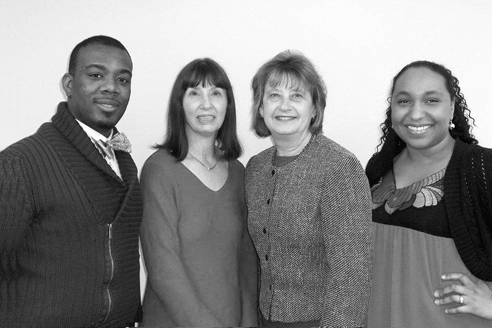http://www.geriatricnursing.org
Building Academic Geriatric Nursing Capacity (BAGNC) Initiative 10th Anniversary
Building Academic Geriatric Nursing Capacity
The John A. Hartford Foundation made its first major investment in nursing in 1996, establishing the Hartford Institute for Geriatric Nursing at New York University. The Hartford Institute focuses on strengthening gerontological nursing in baccalaureate education and in clinical practice, and influencing health policy. The Institute identifies and develops best practices in nursing care of older adults and infuses these practices into the education of nursing students and the work environment of practicing nurses.
 Dr. Claire Fagin, Ms.Patricia Franklin and Dr. Patricia Archbold.
Dr. Claire Fagin, Ms.Patricia Franklin and Dr. Patricia Archbold.
The Hartford Institute has been very successful, as highlighted in the Foundation’s 2006 Annual Report. But it became clear that the ability of nursing schools to adequately prepare gero-competent nurses was limited, at least in part, by the small number of nursing faculty expert in this area. The field of geriatric nursing could not sufficiently grow without well-trained, dedicated, and influential leaders in academia.
Claire M. Fagin, PhD, RN, former Dean of the University of Pennsylvania School of Nursing, a pioneer in nursing, along with Corinne H. Rieder, EdD, Executive Director of the John A. Hartford Foundation, and Donna I. Regenstreif, PhD, then Senior Program Officer at the Foundation, crafted an initiative to address the critical shortage of leaders in geriatric nursing research and education.
 The BAGNC Coordinating Center team at the American Academy of Nursing, (left to right) Thomas Webb, Penny Roberts, Cheryl Sullivan, Faswilla Sampson.
The BAGNC Coordinating Center team at the American Academy of Nursing, (left to right) Thomas Webb, Penny Roberts, Cheryl Sullivan, Faswilla Sampson.
Better Research, Better Education, Better Practice
“The main mission of the BAGNC Initiative is to create well-prepared, productive academic geriatric nurses who are able to conduct research that underpins care, teach the next generation of nurses so that they are enthusiastic and knowledgeable in the care of elders, and lead change in schools of nursing and health care systems,” says Dr. Archbold.
The BAGNC program accomplishes its goals through four primary activities: faculty development, leadership development, collaboration among the Centers of Geriatric Nursing Excellence, and dissemination of Hartford nursing resources and products. Two of these goals, faculty and leadership development, are exemplified in the upcoming photos and described in detail below.
Faculty Development
The core of the BAGNC Initiative is the gero nurse Scholar and Fellow Awards Program. Each Pre-doctoral Scholar receives $50,000 per year for two years and each Claire M. Fagin Post-doctoral Fellow receives $60,000 per year for two years. The Scholars use the funds for tuition and research costs to finish their dissertation, while Fellows complete a research project. During the award period, they have the opportunity to work with mentors and to attend an annual leadership conference.
Scholars and Fellows are chosen because of their commitment to academic geriatric nursing and the recognition of their potential to teach and inspire nursing students, conduct practice-changing research, and become influential leaders.
Applicants for a scholarship or fellowship must write a professional development plan, which requires them to envision their two years as more than a linear progression through a doctoral program or research project. They are asked to map out, explain, and connect the proposed activities to their professional career goals. They begin this process in collaboration with a senior faculty member or mentor who can help them to imagine their future in academic geriatric nursing. “Mentors can expand an applicant’s view of the field of nursing, health care in general, health policy, teaching, and research, and help the applicant to appreciate the many and varied opportunities and possibilities,” says Ms. Franklin. Mentorship by senior faculty in geriatric nursing research is a critical element of the Scholars and Fellows Award Program. Each Scholar and Fellow is matched with a primary mentor and often one or more secondary mentors. “Mentors help Scholars and Fellows emerge as leaders in the field,” says Ms. Franklin (See profile of Dr. Barbara Resnick).
Most Scholars and Fellows maintain ongoing professional relationships with their mentors long after their Hartford funding has ended. Many of the mentors are BAGNC alumni themselves, demonstrating how the program continues to give back to the field of nursing (see profile of Dr. Lisa Skemp).
Hartford Centers of Geriatric Nursing Excellence
Arizona State UniversityOregon Health & Science University
The Pennsylvania State University
University of Arkansas for Medical Sciences
University of California, San Francisco
University of Iowa
University of Minnesota
University of Pennsylvania
University of Utah
Donald W. Reynolds Center of Geriatric Nursing Excellence
University of OklahomaFaculty development is also a major goal of the nine Hartford Centers of Geriatric Nursing Excellence, each of which has programs in place to increase the overall number of geriatric nursing faculty. The Centers are recruiting doctoral students committed to careers in geriatric nursing, creating programs to enhance the curriculum with more geriatric content, providing gero-focused development opportunities for existing faculty, and supporting Scholars and Fellows.
Leadership Development
In addition to building their individual careers as academic nurses, Scholars and Fellows are expected to function as leaders within their institutions, within nursing, and the health care environment. The field of geriatric nursing will advance only if nurses are able to bring about change by positioning themselves in influential roles to create interdisciplinary, evidence-based systems in which the health care needs of older adults are a priority. To do so, nurses need the skills and opportunities.
 Book signing forDr. Angela McBride’s The Growth and Development of Nurse Leaders at the 2010 BAGNC Leadership Conference, New Orleans.
Book signing forDr. Angela McBride’s The Growth and Development of Nurse Leaders at the 2010 BAGNC Leadership Conference, New Orleans.
The BAGNC program offers leadership skill building through an annual Leadership Conference developed by Angela McBride, PhD, RN, Distinguished Professor and Dean Emerita, Indiana University School of Nursing, Indianapolis, and author of The Growth and Development of Nurse Leaders.
“All doctorally prepared nurses are leaders, but at the stage of training they may not yet own that concept,” says Dr. McBride. “At the Leadership Conference we convey the concept that the skill building they get now is connected to their ever-increasing leadership responsibilities as they develop in the field.”
Building on Success
In 2006, program leaders recognized that the BAGNC Initiative was growing a significant cadre of alumni. Many BAGNC alumni continued to communicate and collaborate post-Hartford funding, but there was no structured opportunity to do so. Therefore, the BAGNC coordinating center provided seed money and support for alumni to organize receptions, symposia, and other activities at each of the four annual regional nursing research society meetings. These activities allow alumni to continue to develop a network of resources, support, and collaboration and to raise awareness about geriatric nursing.
 Rachael Watman from the Hartford Foundation and Susan Hassmiller from the Robert Wood Johnson Foundation addressing the Hartford Geriatric Nursing Initiative directors.
Rachael Watman from the Hartford Foundation and Susan Hassmiller from the Robert Wood Johnson Foundation addressing the Hartford Geriatric Nursing Initiative directors.
In 2010, BAGNC alumni, led by Adriana Perez, PhD, RN, ANP, at Arizona State University (see profile), demonstrated great initiative by formally establishing a BAGNC Alumni Association Network. The Alumni Network serves as a structured mechanism to maintain strong connections with colleagues and to promote and sustain the BAGNC program. The Alumni Network has created a page on the professional social networking site LinkedIn (www.linkedin.com), where alumni can share ideas and stay connected. The Alumni Association sponsored a symposium at the 2010 Gerontological Society of America meeting and has contracted with the journal Research in Gerontological Nursing to publish a special issue in 2011 highlighting ten years of BAGNC research.
“The impetus behind the Alumni Association was an opportunity to give back to the Hartford Foundation and the BAGNC program for the commitment and confidence they’ve placed in us as nurses,” says Dr. Perez. “Our goal is to support each other in our scholarship and practice and to share resources and expertise.”
Collaboration with other Funders
Another mechanism to sustain the work of the BAGNC Initiative is partnerships. To advance its mission and overall impact, the John A. Hartford Foundation places a high priority on developing and co-funding projects with other foundations and federal agencies.
As a result, the BAGNC Initiative has benefited from the generosity of many funders. The Atlantic Philanthropies contributed $5.4 million since 2004 to fund Claire M. Fagin Post-doctoral Fellows. The Mayday Fund has provided additional support to BAGNC awardees focused on pain. In 2010 the Jonas Center for Nursing Excellence provided funds for a scholarship at each of the nine Hartford Centers of Geriatric Nursing Excellence. “The point of all of this is better patient care,” says Darlene Curley, MS, RN, Executive Director of the Jonas Center. “By all of the foundations working together, sharing resources, expertise, and passion, patient care will be improved.”
Partnering can also take the form of sharing knowledge, expertise, and model development. In 2008, the Donald W. Reynolds Foundation, a major philanthropy in the field of aging, funded a Center of Geriatric Nursing Excellence at the University of Oklahoma, modeled on the nine existing Hartford centers.
Accomplishments and Impact
Ultimately, the goal of the BAGNC program is to improve the health of older adults by ensuring that all nurses are competent to care for our aging society.
“The most important outcome of the BAGNC Initiative is a vibrant, motivated, and well-prepared national network of academic geriatric nurse colleagues,” says Dr. Archbold. Including the 2010 cohort, 102 Scholars and 70 Claire M. Fagin Fellows have been part of the program.
 Norman H. Volk, Chairman, the John A. Hartford Foundation, with outgoing BAGNC Program Manager Patricia Franklin at the 2010 BAGNC Leadership Conference.
Norman H. Volk, Chairman, the John A. Hartford Foundation, with outgoing BAGNC Program Manager Patricia Franklin at the 2010 BAGNC Leadership Conference.
Evaluation data by Shoshanna Sofaer, DrPH, and her colleagues at Baruch College show BAGNC alumni to be highly productive in research and scholarship (http://geriatricnursing.org/about/program-impact.asp). The average BAGNC alumnus is academically productive, having published six peer-reviewed articles and obtained nearly $200,000 in research grants related to the care of older adults. Alumni scholarship addresses a wide range of timely elder-care topics, such as making life-sustaining treatment decisions, evaluating nursing home management characteristics and outcomes for elders, improving cognition and function through exercise, and assessing and managing pain in elders.
BAGNC Scholars, Fellows, and alumni are actively involved in teaching geriatric nursing (see profile of Dr. Donald Bailey, Jr.). As of July 2010, they had taught geriatric nursing content to nearly 33,000 undergraduate and graduate students. They also influence geriatric nursing nationally, having contributed to projects like the Geriatric Nursing Education Consortium, a faculty development program within the American Association of Colleges of Nursing (www.aacn.nche.edu/gnec.htm) (see profile of Ms. Melissa Aselage).
“As a result of ten years of investment, there is now a cadre of BAGNC alumnae over 170 strong,” says Rachael A. Watman, Senior Program Officer, the John A. Hartford Foundation. “They are improving the care of older adults across the nation—in rural areas, in clinical settings, in Tribal communities, and in the home. These BAGNC alumni are tailoring their research and interventions to focus on the unique needs of older adults. BAGNC leaders have started exercise programs. They’ve explored the lives of those with hoarding behaviors and worked to maximize their safety and independence. They are teaching the next generation of nursing students, and embracing the full spectrum of technology to do so. We at the John A. Hartford Foundation are enormously proud of the BAGNC champions, and we are pleased to share their stories with you.”
A Day in the Life of an Academic Geriatric Nurse ›